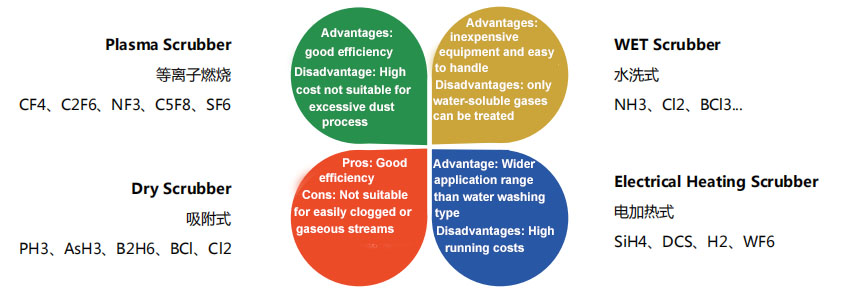Tail gas treatment equipment can handle gases used in etching processes and chemical vapor deposition processes in the semiconductor, liquid crystal, and solar energy industries, including SiH4, SiH2Cl2, PH3, B2H6, TEOS, H2, CO, NF3, SF6, C2F6, WF6, NH3, N2O, and so on.
Exhaust gas treatment method
According to the characteristics of exhaust gas treatment, the treatment can be divided into four types of treatment:
1. Water washing type (treatment of corrosive gases)
2. Oxidizing type (dealing with combustible and toxic gases)
3. Adsorption (according to the type of adsorption material to deal with the corresponding exhaust gas).
4.Plasma combustion type (all types of exhaust gases can be treated).
Each type of treatment has its own advantages and disadvantages as well as its scope of application. When the treatment method is water washing, the equipment is cheap and simple, and can only handle water-soluble gases; the application range of the electric water washing type is higher than that of the water washing type, but the operation cost is high; the dry type has good treatment efficiency, and is not applicable to the gas flow that is easy to be clogged or flowed.
Chemicals and their by-products commonly used in the semiconductor industry can be categorized according to their chemical properties and their different ranges:
1. Flammable gases such as SiH4H2, etc.
2. Toxic gases such as AsH3, PH3, etc.
3. Corrosive gases such as HF, HCl, etc.
4. Greenhouse gases such as CF4, NF3, etc.
Since the above four gases are harmful to the environment or human body, must prevent its direct emission into the atmosphere, so the general semiconductor plant are installed with a large centralized exhaust gas treatment system, but this system is only water scrubbing exhaust, so its application is limited to the long-distance water-soluble gases, and can not deal with the ever-changing and subtle division of the semiconductor process exhaust gas. Therefore, it is necessary to select and match the corresponding exhaust gas treatment equipment according to the gas characteristics derived from each process in order to solve the exhaust gas problem in a small way. As the working area is mostly away from the central exhaust gas treatment system, often due to gas characteristics lead to crystallization or dust accumulation in the pipeline, resulting in clogging of the pipeline leading to gas leakage, and in serious cases, even cause an explosion, can not ensure that the site staff’s work safety. Therefore, in the work area need to configure a small exhaust gas treatment equipment suitable for the characteristics of the process gas, in order to reduce the stagnant exhaust gas in the work area, to ensure the safety of personnel.
Post time: Aug-10-2023

